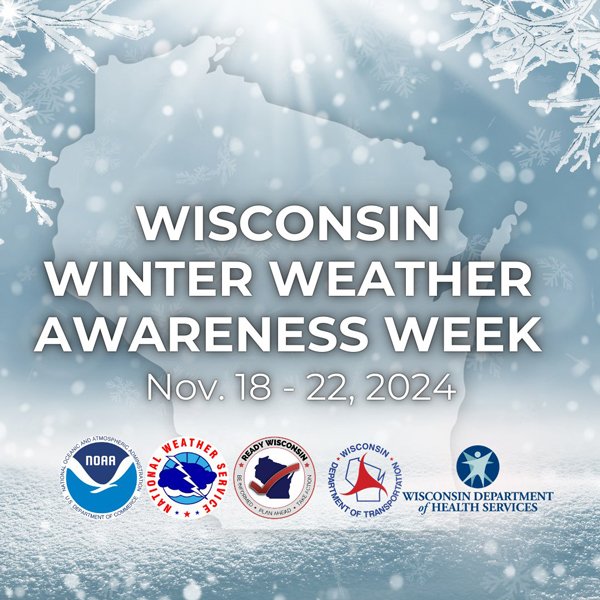MADISON — As winter approaches and before colder temperatures set in, now is the perfect time to plan and be prepared for the upcoming season. To help encourage everyone to be winter ready, Gov. Tony Evers has declared Nov. 18-22 as Winter Weather Awareness Week in Wisconsin.
“Winter weather can lead to dangerous conditions including snowstorms, icy roads, and below freezing temperatures,” said Greg Engle, Wisconsin Emergency Management administrator. “By planning ahead, we can ensure families and communities are safe during the colder winter months.”
Being aware of weather conditions is essential for being prepared. The National Weather Service (NWS) and other reliable local sources will have forecast information to inform you of potential inclement weather. Recently, the NWS simplified their cold weather terminology.
● Wind Chill Watches were renamed to an Extreme Cold Watch
● Wind Chill Warnings were renamed to an Extreme Cold Warning
● Wind Chill Advisory was renamed a Cold Weather Advisory
“These changes are part of a nation-wide effort to simplify the amount of hazard headlines the National Weather Service has,” said Tim Halbach. “Instead of using separate terms like ‘Extreme Cold’ and ‘Wind Chill’ warnings to describe similar cold conditions, they will now use just one: ‘Extreme Cold Watch/Warning/Advisory.’ This is because there are situations that can be extremely cold without much wind.”
Extreme cold temperatures can be dangerous for many people, leading to cold-related illnesses and injuries such as hypothermia and frostbite. There were 45 cold-related deaths in the state during the winter months of 2023-2024, according to preliminary data from the Wisconsin Department of Health Services. According to that data, there were 861 emergency department visits and 225 hospitalizations in the state due to cold-related illnesses.


“Getting ready for snow and bitter cold before they hit can help prevent trips to the emergency room and it might even save a life,” said Paula Tran, state health officer and administrator for the Wisconsin Department of Health Services. “During cold snaps, it’s especially important to check on neighbors and loved ones to make sure they’re warm enough where they are and help get them to a warm space if needed.”
When dangerously cold temperatures arrive, it’s important to follow extreme cold warnings and minimize time outdoors, including pets. If you have to be outside, dress for the weather and make sure you cover exposed skin to reduce your risk of frostbite and hypothermia. Call 211 or visit https://211wisconsin.communityos.org/ to find local warming centers and free winter clothing outlets. Finally, take precautions to avoid slips, trips, and falls in icy conditions and snow shoveling injuries.
When dangerously cold temperatures arrive, it is important to reduce outdoor activities for your family, including your pets. Make sure you wear several layers of loose-fitting, lightweight clothing instead of a single heavy layer. Outerwear should be tightly woven and water-repellent. Make sure you cover exposed skin to reduce your risk. It is also important to know the signs and symptoms of frostbite and hypothermia.
Ice and snow on the roads are a major threat to drivers throughout the state, causing thousands of motor vehicle crashes each year. Preliminary data from the Wisconsin State Patrol shows nine people were killed and 2,262 were injured in the state last winter from crashes involving winter road conditions.
“We all have a responsibility to protect each other and our plow drivers who work long hours to keep roads clear and help us get where we need to go,” WisDOT Secretary Kristina Boardman said. “We ask drivers to remember the basics: slow down, maintain extra following distance from other vehicles and avoid distractions so you can focus on getting to your destination safely. Check 511 Wisconsin to stay up to date on road conditions and know before you go.”
511 Wisconsin is a free website and mobile app that provides traffic and route-specific information. It is important to check 511 Wisconsin before you drive. To learn more about traffic information or check out hundreds of traffic cameras statewide, people can access the mobile-friendly website at www.511wi.gov.


At home or in your car, winter emergency kits should include items such as food, water, a flashlight and batteries, and blankets. In your vehicle, include a snow shovel, extra gloves and hats, cell phone charger, and kitty litter or sand to help give your wheels traction on icy roads if your vehicle gets stuck.
To prepare for winter storms, stock up on additional supplies and have a plan for what to do if you lose power at home. Plan for extra batteries and other alternative power sources for your needs, including power banks or a generator. Keep generator safety in mind while it is in operation to prevent carbon monoxide poisoning and other hazards.
● Generators should be used outdoors and at least 20 feet away from windows, doors, and attached garages
● Make sure you have working carbon monoxide detectors on every level of your home
● Follow manufacturer’s instructions carefully
According to the NWS, Wisconsin experiences an average of three to six winter storms during the season. Last winter, the highest one-day snowfall total in the state of 17 inches was reported in Jackson, located in Washington County on Jan. 13, 2024. Hurley in Iron County recorded 75.5 inches of snow last winter, giving it the highest seasonal snowfall total in the state. The coldest temperature recorded in Wisconsin last winter was -18 degrees Fahrenheit on Jan. 15-16, 2024, in Clinton, located in Rock County.
Follow ReadyWisconsin on Facebook, X, and Instagram for tips throughout the winter months and updates on dangerous weather conditions.
Learn more tips at dhs.wi.gov/climate/winter-weather.htm.



